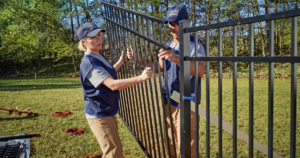If you’re looking for a basic window covering that can provide privacy and light control, blinds and shades are an excellent choice. These versatile options are available in a range of styles and colors to fit your home’s aesthetic.

Unlike ready-made options, custom blinds are designed to match your window dimensions precisely. That’s why they offer a polished look and superior functionality. Contact Custom Blinds And Shades KY for professional help.
The best window blinds and shades should offer you a perfect fit while coordinating with your décor. This way, you can create a cohesive look throughout your home and optimize light control. These window coverings should also be energy efficient and provide privacy. Additionally, they should be easy to clean and durable.
Unlike off-the-shelf options, custom window shades are made according to your exact measurements. This ensures that there are no gaps between the window and the blinds. The result is a more attractive, more uniform look that won’t allow light to sneak through and into the room. Furthermore, you can choose from a variety of fabrics and colors to suit your décor.
Custom window blinds can also be customized to fit any type of window, including arched and angled windows. However, they may take a few weeks to be delivered. During this time, you can still use your old window treatments or purchase a set of temporary blinds.
When choosing the right shade for your home, consider whether you want it to be hard or soft. Hard shades can add a modern feel to your space, while soft shades are a good choice for a cozy room. Lastly, you should consider how much light you want to let into your home and whether or not you need a blackout fabric.
There are many different types of window treatments available, from classic roller shades to cellular shades and woven woods. Each of these options has its own unique advantages, so it’s important to understand your style and requirements before making a selection.
Roller shades are an affordable option that offers simplicity and functionality. These window treatments are a single piece of fabric attached to a rolling mechanism and come in a wide variety of colors and patterns. They are also available in a variety of widths, so you can find the perfect size for your windows.
Another option is to go for a classic roman shade. These layered window treatments consist of one piece of fabric that lies flat when lowered, and creates horizontal pleats when raised. They are a popular choice for both traditional and contemporary homes, and they can be customised to fit any size or shape of window.
They are easy to clean
A regular dusting can help keep window blinds and shades clean and fresh. But when slats and vanes collect debris and dirt, they may need a more thorough cleaning. Using a cloth that is damp, but not soaking wet, wipe the blinds, from side to side and top to bottom. This will remove loose surface dust and dirt that tends to accumulate in hard-to-reach corners. To prevent the fabric from getting wet, use a microfiber cloth. Microfiber cloths are like the Olympic champions of dust collection, and they won’t scratch or snag soft fabrics.
If wiping isn’t enough, the next step is to wash the window blinds. Fill a bathtub or large washing sink with warm water and add a few drops of dish soap. Dip a cloth in the soapy water and wipe each slat, rinsing the cloth with more soapy water as it gets dirty. When you’re finished, rinse the window blinds with clean water and hang them to dry.
While the method of cleaning will vary slightly depending on your type of window blinds, most steps are the same. For instance, wood or faux wood blinds that can’t be immersed in water can be cleaned by using a brush attachment on your vacuum cleaner. For wooden blinds with painted or stained finishes, you can also use a sponge or toothbrush to scrub the surface.
The slats and vanes on window blinds attract and hold dirt and allergens, so they should be cleaned regularly to keep them looking nice. If your blinds are especially soiled, you can add a few drops of fabric cleaner to your damp cloth and gently rub them down. Always test your cleaner on a small area of the blinds to make sure that it doesn’t damage or discolor them.
Once your window blinds are dry, they’re ready to be installed again. But if you don’t want to go through the hassle of reinstalling them, you can replace your old blinds with custom made ones. These are typically higher quality and offer a better fit, plus they’ll provide a more unique solution for your home. They’ll also be easier to clean than ready-made options, which can leave marks or become discolored in sunlight.
They offer privacy
The right window shades and blinds can not only complement your home’s interior design but also improve glare, privacy, and temperature regulation. These purpose-designed options can even protect your family from harmful UV rays and help reduce energy costs in the long run.
There are several different options to choose from, including cellular shades, honeycomb blinds, pleated shades, and shutters. These are a great choice for both traditional and modern homes. Each type offers unique benefits, such as a layered look, light filtering, and energy efficiency. In addition, custom blinds and shades are available in a variety of colors, patterns, and textures to perfectly coordinate with your room’s decor. For instance, hardwood blinds can match floors and soft roman shades can align with carpets and furniture. Other features include cordless operations and child safety features, which make them a better option for homes with small children.
Blinds and shades can be used to transform floor-to-ceiling windows into a fourth wall with graceful color and texture. They can also act as a sleek room divider or closet doors. They offer a variety of design possibilities, such as a sliding track or a retractable system that allows them to be pulled back like curtains when open. Moreover, they can be angled strategically to allow in sunlight while blocking sightlines. In the same way, they can be closed to create a dark and private space for sleeping or relaxing.
Both blinds and shades offer privacy by obscuring the view from outside, though there is nuance in their privacy functions. For example, a sheer fabric can prevent a detailed view from inside the window while still displaying silhouettes, and different construction materials affect the privacy level of each type of shade.
Regardless of the style of your house, custom window blinds and shades are the best choice to ensure a perfect fit. Compared to ready-made blinds, they’re usually of higher quality and more durable. In addition, they’re easier to clean and can last for years without fading or breaking. This is because they’re made to suit your home’s specific size and shape. However, you should consider that they’re more expensive than ready-made blinds.
They are more expensive
While Custom Blinds and Shades are more expensive than ready-made options, they offer a higher quality, a precise fit for your window’s dimensions, and better craftsmanship. They also provide more options for style and design, including advanced features like motorization. These additional features add to the cost, but they can be a game-changer for modern homes that want to control their windows with the press of a button or integration into their smart home systems.
However, there are a few things you can do to help stretch your budget when upgrading to custom shades. One option is to dress fewer windows, which will lower your overall cost. Another is to save upgrades like motorization for the areas of your home that you use most often, such as living spaces and main bedrooms. Finally, you can choose to only purchase the highest-quality shades for the most prominent windows in your home, and select a less expensive treatment for secondary or smaller windows.
The cost of Custom Blinds and Shades varies depending on the type you choose, fabric, lift options, and installation labor. For example, a classic roller shade will cost between $25 and $350 per window. This classic fixture wraps fabric around a tube, which allows you to draw and retract it with a cord or remote.
You can also choose a more luxurious look with a roman shade. These stylish window treatments feature wide slats that stack on top of each other when they’re drawn, creating a layered appearance. They can be made from any fabric, though woven woods and faux-wood materials are popular choices.
You may also opt for a cellular shade, which increases your home’s energy efficiency by trapping air inside its honeycomb-like pockets. The slats can be drawn or retracted using a pull string, and they can be operated in a manual or motorized fashion. These shades can be a bit more expensive, but they’re an excellent choice for homeowners who want to cut down on energy costs.
While custom window blinds and shades are more expensive than their ready-made counterparts, they’re worth the investment in the long run because they last longer and look better. Moreover, custom blinds are typically easier to clean and offer more options for style and design. They also eliminate the need for multiple trips to the store, which can save you time and money.








